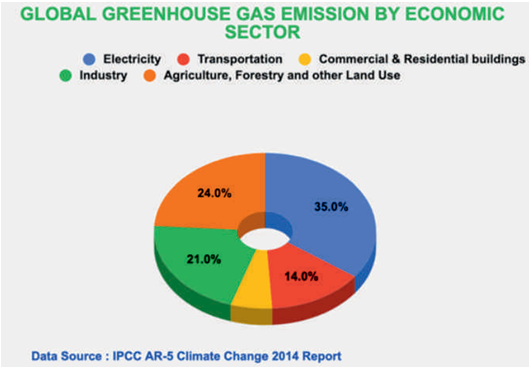Harnessing the power of the Stars Fusion Energy for a Sustainable Future
Scientists, environmentalists, and world leaders are continuously focusing their attention on finding a solution to the abatement of anthropogenic climate change, resulting from the rapid rise in greenhouse gas emissions, which are threatening the planet’s ecosystems.In the last century, our planet has undergone a drastic rise in temperature, 1.1°C since the pre-industrial period (1850-1900). Global carbon dioxide emissions from fossil fuels and industry totaled 37.01 billion metric tons in 2023.Emissions are projected to have risen 1.08 percent in 2024 to reach a record high of 37.41 billion metric tons. Since 1990, global CO2 emissions have increased by more than 60 percent. The major threats of climate change include water conflicts, agricultural disruptions, increased natural disasters, risks to critical infrastructure, economic instability, widening inequality, public health threats, resource-related geopolitical conflicts, and risks to the planet’s biodiversity.
The electricity and transportation sectors together account for about half of the global emissions and that is why the main focus is on transiting these two economic sectors from fossil fuel to renewables to reach net zero. With the corresponding contribution of Coal, Methane, Nitrous oxide and Fluorinated gases in total greenhouse gases emissions as 76%, 16%, 6% and 2%, global warming has started to exhibit its adverse impact across the globe. The detrimental outcomes of climate change on different sectors of society are increasingly visible globally. The threat is expected to grow most likely in a nonlinear way until the world achieves transitions to a net zero economy which is one of humankind’s greatest challenges. The historic Paris Agreement (COP21) has set out a global framework to mitigate climate change by limiting global warming to well below 2°C above pre-industrial levels and pursuing efforts to limit it to 1.5°C. It marked the beginning of a shift towards a net zero emission world.
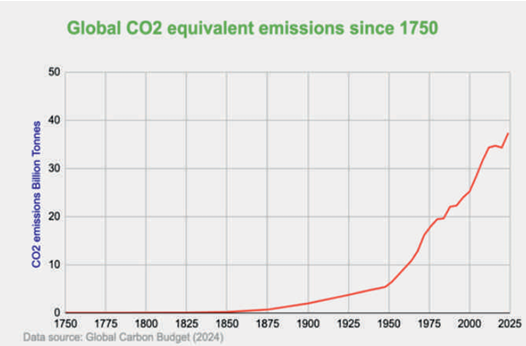
organizations are constantly working to incorporate climate resilience and adaptation strategies into their planning. The transportation sector is quickly shifting to green fuels, while the reliance on fossil fuels for electricity is declining as renewable energy sources gain ground. Though existing renewable energy resources are core elements to mitigate climate change, they are not sufficient on their own. Solar and wind energy have an inherent intermittent quality and cannot substitute for baseload generation.Solar, Wind, hydro and geothermal sources have seen substantial growth over the period but they still account for about one-third of global electricity generation, thereby forcing reliance on fossil fuels for base load power requirements. Nuclear fission power could serve as an alternative to fossil fuels for reliable energy supplies, but it faces significant challenges, including high upfront costs, lengthy development timelines, geopolitical risks, and public concerns about radioactive waste and safety. The inherent limitations of nuclear fission technology make it less attractive, highlighting the need for the development of new technologies that are as efficient as nuclear fission to meet baseload power requirements. This is where nuclear fusion technology comes into play, although it is still in the research and development phase.
Nuclear fusion technology holds the potential to revolutionize energy production by offering a clean and virtually limitless source of power with minimal environmental impact. Unlike nuclear fission, which powers current nuclear reactors through the splitting of heavy atomic nuclei like uranium-235 or plutonium-239, nuclear fusion generates energy by combining light atomic nuclei into a heavier one, mimicking the process that powers the sun. While fission produces long-lasting radioactive waste that requires careful disposal, fusion generates minimal waste, most of which has a much shorter half-life. Additionally, the supply of nuclear fission fuel is heavily influenced by geopolitical factors and international sanctions, whereas fusion fuel, primarily isotopes of hydrogen, is abundant and widely available across the globe.
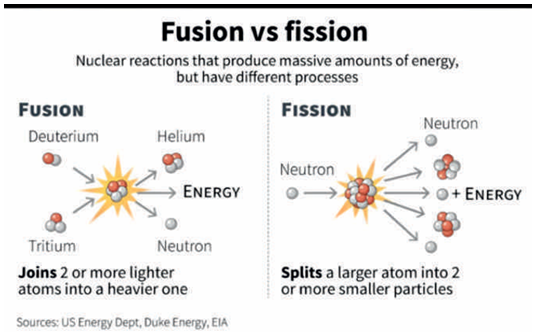
The concept of thermonuclear fusion was first understood in the 1930s. In 1950, American physicist Ira B. Bernstein described the necessity of a magnetic field to create magneto-hydrodynamically stable conditions for the fusion plasma. Since then, scientists and engineers have been relentlessly pursuing the goal of harnessing fusion energy for commercial purposes. While the Sun’s massive gravitational force naturally induces fusion, without that force, a temperature at least ten times higher than in the Sun is needed for the reaction to take place. On Earth, temperatures exceeding 100 million degrees Celsius are required to induce fusion between deuterium and tritium. Simultaneously, it is necessary to regulate pressure and magnetic forces to ensure stable plasma confinement. The first successful controlled thermonuclear fusion reactions in a laboratory were achieved in 1958 at Los Alamos National Laboratory (LANL) of the United States Department of Energy. Achieving the dream of commercial fusion power has been the Holy Grail of engineering for the last 80 years. A major breakthrough occurred on 5th December 2022, when scientists performing an inertial confinement fusion (ICF) experiment at the National Ignition Facility (NIF) at Lawrence Livermore, USA, achieved producing more energy from the self-sustaining controlled fusion reaction than was consumed to create it, with an energy gain factor of 1.5. This is one of the most impressive scientific achievements of the 21st century, as fusion could generate four times more energy from the same amount of fuel than fission, and nearly four million times more energy than burning oil or coal. Recently, France set a new record by sustaining a fusion reaction for over 22 minutes, surpassing the previous record of 18 minutes held by China.
Fusion fuels, such as deuterium and tritium, are derived from water and lithium, respectively. Deuterium is abundant in water, while tritium is produced by irradiating lithium-6 with neutrons. Additionally, tritium is also generated as a by-product in both fission and fusion reactions. This characteristic makes the fuel supply for fusion potentially more sustainable, as tritium can be bred directly within the reactor itself.
Fusion energy is considered vital for future climate change strategies, as it holds the potential to provide boundless, clean, and sustainable energy. Unlike fossil fuels, fusion generates no carbon dioxide or other greenhouse gases during energy production. This makes fusion energy a promising alternative to fossil fuels, offering the potential to significantly reduce greenhouse gas emissions and play a key role in mitigating climate change. As such, fusion energy could prove to be an invaluable clean energy source.
Fusion processes produce significantly less radioactive waste, with shorter half-lives, thereby reducing the long-term environmental impact and challenges associated with waste management. Fusion energy also eliminates the risk of catastrophic accidents like meltdowns, as the conditions required to sustain a fusion reaction, extremely high temperature, pressure, and confinement, are difficult to maintain, and the reaction would quickly cease if these conditions are not met. However, fusion reactions rely on powerful magnetic fields to confine the hot plasma, and uncontrolled instabilities remain a challenge. Additionally, tritium, a radioactive isotope of hydrogen, presents significant safety and environmental risks when handling and storing it, though these risks are not as severe as those associated with managing fission fuels. Therefore, continued research and development are essential to address the potential risks of fusion technology. It is important to note that despite abundance of fuel, harnessing fusion energy on earth is a complex technological challenge.
The simplified overview of how the fusion process is managed in reactors like the Tokamak or Stellarator covers five main stages: fuel preparation, creating extreme conditions to initiate the fusion reaction, confinement methods, the fusion reaction itself, and energy extraction. These stages are briefly explained below: Fuel Preparation: The most common fusion reaction uses isotopes of hydrogen, deuterium and tritium. Deuterium can be extracted from water, while tritium is produced from lithium. There are substantial reserves of lithium on earth that could last for immeasurable period of time.
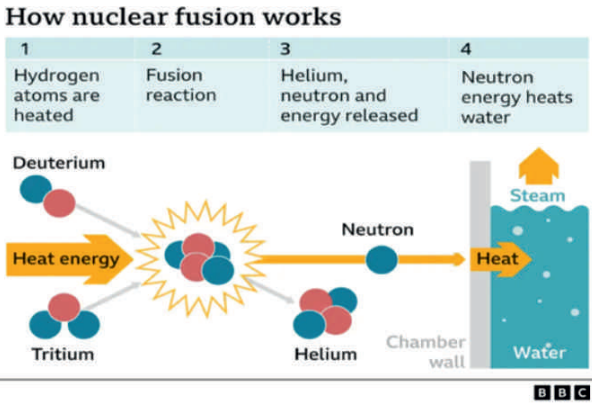
Creating Extreme Conditions: Hydrogen isotopes must be heated to extremely high temperatures, exceeding 100 million degrees Celsius to initiate nuclear fusion. At these temperatures, the gas turns into plasma, an electrically charged state of matter where electrons are separated from nuclei.
Confinement Methods: Magnetic confinement uses powerful magnetic fields to contain and control the hot plasma, preventing contact with the reactor walls, whereas Inertial confinement utilises lasers or ion beams to rapidly compress a tiny fuel pellet, creating the extreme temperature and pressure conditions required for fusion. Fusion Reaction: Under these extreme conditions, the nuclei of deuterium and tritium overcome their natural repulsion and fuse together. This reaction produces a helium nucleus, a neutron, and releases a tremendous amount of energy, mostly carried by the neutron. Energy Extraction: The high-energy neutrons, generated during the fusion process, escape the magnetic confinement field and are absorbed by a surrounding lithium blanket. The energy from the neutrons is transferred to the lithium blanket, causing its temperature to rise. This heat is then used to generate steam, which drives turbines to produce electricity, mirroring the process in traditional power plants.
The fusion reaction is achieved in specialized reactors such as Tokamaks and Stellarators. Both utilize powerful magnetic fields to confine plasma in a donut-shaped (torus) configuration, which facilitates the fusion process. In Tokamaks, three sets of large magnetic field coils are used: Toroidal field coils, Poloidal field coils, and the Central Solenoid. These coils work together to create a complex magnetic field that confines and heats the plasma, providing the conditions necessary for controlled nuclear fusion. In contrast, Stellarators rely on an intricate arrangement of multiple magnetic field coils that encircle the plasma. This design creates a complex, three-dimensional twisted magnetic field that wraps around the toroidal shape, eliminating the need for a central current. Stellarators offer several advantages over Tokamaks, including lower power requirements to sustain the fusion reaction, greater design flexibility, and a reduced likelihood of plasma disruptions. However, a significant challenge for Stellarators is their difficulty in confining the most energetic particles within the plasma, which are essential for sustaining the fusion reaction. Scientists are working diligently to address this issue and improve Stellarator technology to make it a viable alternative. Both Tokamaks and Stellarators are effective at maintaining high temperatures and confining plasma, which are crucial for achieving controlled fusion reactions. Tokamaks are among the most common types of magnetic confinement fusion devices, and much of the current research is focused on them to achieve controlled nuclear fusion. However, research into Stellarators is also gaining momentum. Different designs are being explored worldwide to overcome the technical challenges associated with achieving net energy gain from fusion reactions. Each reactor type has its own advantages and challenges, and it is likely that a combination of various designs will pave the way for successful commercial fusion energy.
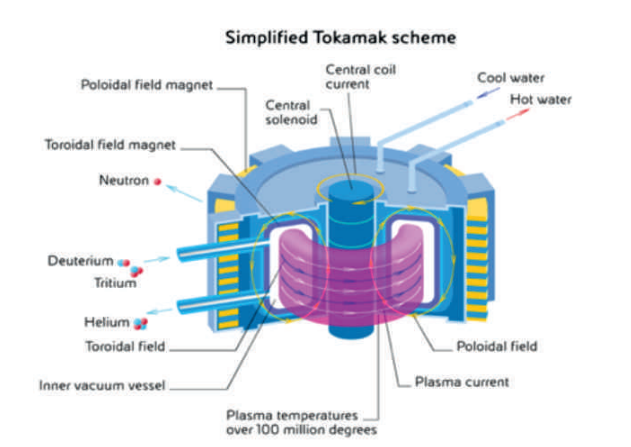
The International Thermonuclear Experimental Reactor (ITER), a flagship of intergovernmental collaboration, is conducting a massive international nuclear fusion research and engineering project involving the European Union, United States, Russia, China, India, South Korea, and Japan. The ITER organisation was officially established on October 24, 2007, after all partners signed the agreement. Based in France, ITER is an intergovernmental scientific and engineering organization responsible for designing, constructing, and operating the reactor. This large-scale scientific experiment aims to demonstrate the feasibility of fusion power as a large-scale, carbon-free energy source. ITER will be the world’s largest experimental tokamak, with the goal of producing 10 times more fusion power than the heat energy used to initiate and sustain the reaction.
ALCATOR-C-MOD, a compact, high magnetic field tokamak at the Massachusetts Institute of Technology (MIT) Plasma Science and Fusion Center (PSFC), has provided much of the research foundation for SPARC, the world’s largest near-commercial experimental fusion reactor currently being developed by the U.S.-based start-up, Commonwealth Fusion Systems (CFS). The SPARC tokamak, a high-field compact fusion reactor, is designed to be the world’s first commercially viable fusion device, aiming to produce more power than it consumes. The SPARC reactor uses advanced high-temperature superconducting (HTS) magnets, with 18 magnets, each producing 20 Tesla. The success of SPARC is expected to pave the way for ARC, a full-scale fusion power plant in Virginia, USA, capable of providing significant grid-connected power.
India is contributing to ITER and has been developing its own domestic fusion program, focusing on tokamak technology and fusion materials. Indian research institutions, such as the Institute for Plasma Research (IPR), have been central to advancing fusion science. The IPR operates the ADITYA and SST-1 (Steady-State Superconducting Tokamak) devices to experiment with plasma confinement and heating. These initiatives emphasize India’s commitment to harnessing nuclear fusion as a future energy solution. The emergence of the domestic private sector, such as Anubal Fusion, a start-up established in May 2024, also highlights India’s growing ambition to participate in fusion technology development. Anubal Fusion has formed partnerships with prominent institutions, including the Tata Institute of Fundamental Research (TIFR) in Hyderabad and IIT Madras.

Two developments in the coming years could mark a significant shift from the public to the private sector in the quest to generate cheap and abundant clean power from fusion. The first is the commissioning of SPARC, the world’s first near-commercial 140 MW experimental tokamak, by the private firm Commonwealth Fusion Systems (CFS), which is expected towards the end of 2025 or early 2026. Following the SPARC demonstration, CFS will proceed with the construction of ARC, the world’s first 400 MW grid-connected fusion power plant, marking a major milestone in the commercialisation of fusion energy. The ARC fusion power plant is targeted to be commissioned by the mid-2030s. The second development is the significant delay in the opening of ITER, which was originally scheduled to be ready by 2025. ITER has postponed its timeline due to several reasons, including the pandemic, which led to supply-chain and quality control delays, component faults, and pauses in construction demanded by the French Nuclear Regulator. As a result, the final stage of the ITER project has been delayed from 2035 to 2039, with a €5 billion cost overrun.
Fusion as a primary energy source by mid-century is becoming increasingly possible. With recent advancements in magnetic confinement and high-temperature superconductors, the vision of harnessing the power of the stars no longer feels like distant science fiction. We may see the first commercial fusion power plants emerge, but widespread adoption will depend on sustained scientific and technological breakthroughs, coupled with global investments and policy support. Until then, other clean energy technologies are likely to continue dominating the energy landscape.
As climate change accelerates, threatening ecosystems and human life, the greatest challenge lies in finding transformative solutions. Fusion energy stands as one of the most promising breakthroughs on the horizon. It offers hope for a cleaner, more sustainable future, a potential game-changer in humanity’s fight against climate change.












